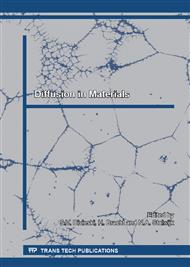[1]
K. Lu et J. Lu, «Nanostructured surface layer on metallic materials induces by surface mechanical attrition treatment, » Materials Science & Engineering, A, Vols. %1 sur %2375-377, pp.38-45, (2004).
DOI: 10.1016/j.msea.2003.10.261
Google Scholar
[2]
T. Roland, D. Retraint, K. Lu et J. Lu, «Fatigue life improvement through surface nanostructuring of stainless steel by means of surface mechanical attrition treatment, » Scr. Mater., vol. 54, pp.1949-1954, (2006).
DOI: 10.1016/j.scriptamat.2006.01.049
Google Scholar
[3]
N. Tao, Z. Wang, W. Tong, M. Sui, J. Lu et K. Lu, «An investigation of surface nanocrystallization mechanism in Fe induced by surface mechanical attrition treatment, » Acta Mater., vol. 50, pp.4603-4616, (2002).
DOI: 10.1016/s1359-6454(02)00310-5
Google Scholar
[4]
W. Tong, N. Tao, Z. Wang, J. Lu et K. Lu, «Nitriding Iron at Lower Temperatures, » Science, vol. 299, pp.686-688, (2003).
DOI: 10.1126/science.1080216
Google Scholar
[5]
H. -W. Zhang, L. Wang, Z. -K. Hei, G. Liu, J. Lu et K. Lu, «Low-temperature plasma nitriding of AISI 304 stainless steel with nano-structures surface layer, » Z. Metallkd., vol. 10, pp.1143-1147, (2003).
DOI: 10.3139/146.031143
Google Scholar
[6]
Y. Lin, J. Lu, L. Wang, T. Xu et Q. Xue, «Surface nanocrystallization by surface mechanical attrition treatment and its effect on structure and properties of plasma nitrided AISI 321 stainless steel, » Acta Mater., vol. 54, pp.5599-5605, (2006).
DOI: 10.1016/j.actamat.2006.08.014
Google Scholar
[7]
W. -P. Tong, C. Liu, W. Wang, N. -R. Tao, Z. -B. Wang, L. Zuo et J. -C. He, «Gaseous nitriding of iron with a nanostructured surface layer, » Scr. Mater., vol. 57, pp.533-536, (2007).
DOI: 10.1016/j.scriptamat.2007.05.017
Google Scholar
[8]
S. -M. Hassani-Gangaraj, A. Moridi, M. Guagliano, A. Ghidini et M. Boniardi, «The effect of nitriding, severe shot peening and their combination on the fatigue behavior and micro-structure of a low-alloy steel, » International Journal of Fatigue , vol. 62, pp.67-76, (2014).
DOI: 10.1016/j.ijfatigue.2013.04.017
Google Scholar
[9]
S. -M. Hassani-Gangaraj, A. Moridi, M. Guagliano et A. Ghidini, «Nitriding duration reduction without sacrificing mechanical characteristics and fatigue behavior: The beneficial effect of surface nano-crystallization by prior severe shot peening, » Materials & Design, vol. 55, pp.492-498, (2014).
DOI: 10.1016/j.matdes.2013.10.015
Google Scholar
[10]
T. Prezeau, T. Muller, E. Dransart et Y. Giraud, «Amélioration par un prétraitement mécanique de NanoPeening, des performances des traitements thermochimiques : Cas de la nitruration et de la carbonitruration basse pression., » Traitements et Matériaux, vol. 412, pp.37-43, (2011).
DOI: 10.51257/a-v1-m1224
Google Scholar
[11]
D. Gryaznov, J. Fleig et J. Maier, «Finite element simulation of diffusion into polycrystalline materials, » Solid State Sci., vol. 10, pp.754-760, (2008).
DOI: 10.1016/j.solidstatesciences.2008.03.030
Google Scholar
[12]
I. -V. Belova et G. -E. Murch, «Diffusion in nanocrystalline materials, » Journal of Physics and Chemistry of Solids , vol. 64, pp.873-878, (2003).
DOI: 10.1016/s0022-3697(02)00421-3
Google Scholar
[13]
L. Bassman, N. Ibrahim, P. Pinsky, K. Saraswat et M. Deal, «Mesoscale Modeling of Diffusion in Polycrystalline Structures, » chez Simulation of Semiconductor Processes and Devices, 1997. SISPAD '97., 1997 International Conference on, (1997).
DOI: 10.1109/sispad.1997.621359
Google Scholar
[14]
E. Hart, «On the role of dislocations in bulk diffusion, » Acta Metallurgica, vol. 5, p.597, (1957).
Google Scholar
[15]
V. Lacaille, E. Feulvarch, G. Kermouche, C. Morel et J. -M. Bergheau, «Finite element analysis of the grain size effect on diffusion in polycrystalline materials, » Com. Mat. Sci., (2014).
DOI: 10.1016/j.commatsci.2014.07.026
Google Scholar
[16]
V. Lacaille, G. Kermouche, D. -Y. Tumbajoy-Spinel, E. Feulvarch, C. Morel et J. -M. Bergheau, «Modeling the nitriding enhancement resulting from the NanoPeening treatment of a pure iron, » IOP Conf. Series : Materials Science and Engineering, vol. 63, (2014).
DOI: 10.1088/1757-899x/63/1/012124
Google Scholar
[17]
«DREAMD 3D, » 2014. [En ligne]. Available: http: /dream3d. bluequartz. net.
Google Scholar
[18]
C. Herzig et Y. Mishin, chez Diffusion in Condensed Matter Chap. 8, Springer, 2005, pp.337-366.
Google Scholar
[19]
«Sysweld User's manual, » (2014).
Google Scholar
[20]
W. -P. Tong, Z. Han, L. -M. Wang, J. Lu et K. Lu, «Low-temperature nitriding of 38CrMoAl steel with a nanostructured surface layer induced by surface mechanical attrition treatment, » Surf. Coat. Tech., vol. 202, pp.4957-4963, (2008).
DOI: 10.1016/j.surfcoat.2008.04.085
Google Scholar


